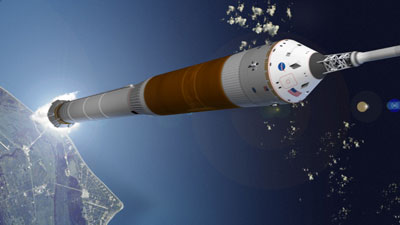Authorizing and stimulating NASAby Taylor Dinerman
|
| Congress has, for all intents and purposes, put international partners and commercial “NewSpace” firms on a level playing field. If this policy holds true during the next administration it will not only be a sea change in the way the US civil space program operates, but may lead to a major change in the way the global space industry operates. |
The fiscal year 2009 NASA authorization bill, which sets policy rather than providing direct funding, contains within it everything NASA and its supporters could reasonably expect. It includes topline funding for the agency of $20.2 billion and allows for the logical next stage of the Commercial Orbital Transportation Services program, Capability D, which could lead to commercial human access to the ISS by either the SpaceX Dragon or an alternative vehicle. For the first time the bill orders NASA to consider international participation and cooperation, as well as commercial involvement in space exploration activities.
Congress has, for all intents and purposes, put international partners and commercial “NewSpace” firms on a level playing field. The intent of the Congress is clear: the heads of JAXA and ESA will now be treated no better and no worse than the heads of SpaceX or Orbital Sciences. If this policy holds true during the next administration it will not only be a sea change in the way the US civil space program operates, but may lead to a major change in the way the global space industry operates.
NASA, of course, desperately needs an infusion of extra funds so that it can meet the authorization bill’s mandate to fly the Alpha Magnetic Spectrometer (AMS) shuttle mission. Building one or more additional external tanks at the Michoud Louisiana facility will be a lot more expensive if they have to restart the assembly line after it has been shut down. This decision is connected to the possibility of flying at least a few extra shuttle missions beyond the AMS one. One casualty of both the authorization bill and the delays in launching STS-125, the Hubble repair mission, is that the September 2010 shutdown date for the shuttle will likely have to be pushed back.
As things stand NASA has been planning to quit building tanks for the shuttle and start building tanks for the Ares 1 and Ares 5 launchers sometime soon. Without more funding for shuttle tanks, the workforce at Michoud will begin to fade away within a few months or even weeks. The area was badly hit by Katrina in 2005 and has not yet fully recovered. Many of the workers have stayed on the job in difficult circumstances out of devotion to the space program. Keeping them in suspense while they wait to find out if they will have jobs over the next few months is unfair to a team that has performed outstandingly well since the Columbia disaster in 2003.
In spite of the predictable complaints, NASA under Mike Griffin has done a pretty good job of keeping a balance between robotic and human spaceflight. The problem is that the needs of the Constellation program—including Ares 1 and 5 and the Orion capsule as well as early work on the Altair lunar lander and other systems for manned space exploration—demand a lot of upfront investment, and keeping the shuttle flying eats into the available cash. The science community, which had been expecting a steady increase in its overall funding, lost out and has been struggling to keep many of its ambitious projects alive.
A modest increase in overall science funds as part of the NASA stimulus package would not only help keep major programs such as the Mars Science Laboratory on track, but would allow a few of the underfunded space and Earth science projects, such at the Solar Sentinels heliophysical monitoring satellites, to catch up.
| The positive regional effects of NASA spending are not really enough to justify extra “stimulus” money. The biggest justification of all is the impact of the government space program on the quality of the overall workforce. |
Yet the great question for the politicians will be, how does this stimulate the economy? Aside from keeping thousands of highly trained workers, engineers, and scientists gainfully and productively employed, keeping NASA healthy is important to the overall success of America’s technology sector. NASA’s centers can contribute to the creation of high-tech centers of excellence. The relationship between Ames and Silicon Valley is obvious, the role of the Kennedy Space Center in the creation of the central Florida aerospace industry has yet to be examined, and there are probably other examples out there.
The positive regional effects of NASA spending are not really enough to justify extra “stimulus” money. The biggest justification of all is the impact of the government space program on the quality of the overall workforce. If the space program were to be eviscerated the way it was in the 1970s it would lead to thousands of highly trained men and women leaving the space industry for good. The lost expertise would create a hole in the national skill set that would take decades and tens of billions of extra dollars to fill.
The worst effect would be on the next generation of scientists and engineers who would see their predecessors being treated like expendable Line Replacement Units and find alternative careers. Stimulating NASA now means a healthy economy four or eight years from now, just when some of these politicians will be running for reelection.
